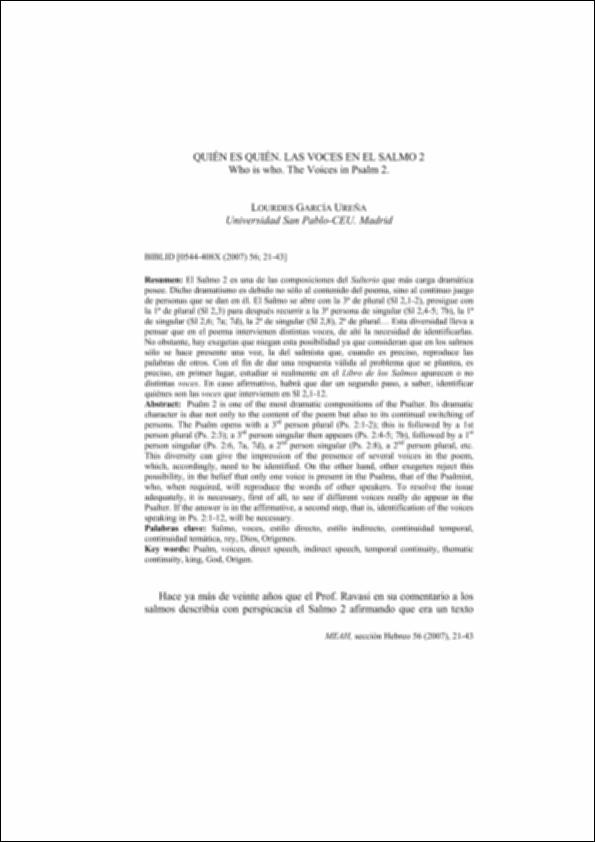Please use this identifier to cite or link to this item:
http://hdl.handle.net/10637/11870Quién es quién : las voces en el Salmo 2
| Title: | Quién es quién : las voces en el Salmo 2 |
| Other Titles: | Voices, direct speech, indirect speech, temporal continuity, thematic continuity |
| Authors : | García Ureña, Lourdes |
| Keywords: | Salmos 2; Voces; Estilo directo; Estilo indirecto, continuidad temporal, continuidad temática, rey, Dios, Orígenes.; Continuidad temporal; Continuidad temática; Dios; Orígenes; Psalm 2; Direct speech; Indirect speech |
| Abstract: | El Salmo 2 es una de las composiciones del Salterio que más carga dramática
posee. Dicho dramatismo es debido no sólo al contenido del poema, sino al continuo juego
de personas que se dan en él. El Salmo se abre con la 3ª de plural (Sl 2,1-2), prosigue con
la 1ª de plural (Sl 2,3) para después recurrir a la 3ª persona de singular (Sl 2,4-5; 7b), la 1ª
de singular (Sl 2,6; 7a; 7d), la 2ª de singular (Sl 2,8), 2ª de plural… Esta diversidad lleva a
pensar que en el poema intervienen distintas voces, de ahí la necesidad de identificarlas.
No obstante, hay exegetas que niegan esta posibilidad ya que consideran que en los salmos
sólo se hace presente una voz, la del salmista que, cuando es preciso, reproduce las
palabras de otros. Con el fin de dar una respuesta válida al problema que se plantea, es
preciso, en primer lugar, estudiar si realmente en el Libro de los Salmos aparecen o no
distintas voces. En caso afirmativo, habrá que dar un segundo paso, a saber, identificar
quiénes son las voces que intervienen en Sl 2,1-12. Psalm 2 is one of the most dramatic compositions of the Psalter. Its dramatic character is due not only to the content of the poem but also to its continual switching of persons. The Psalm opens with a 3rd person plural (Ps. 2:1-2); this is followed by a 1st person plural (Ps. 2:3); a 3rd person singular then appears (Ps. 2:4-5; 7b), followed by a 1st person singular (Ps. 2:6, 7a, 7d), a 2nd person singular (Ps. 2:8), a 2nd person plural, etc. This diversity can give the impression of the presence of several voices in the poem, which, accordingly, need to be identified. On the other hand, other exegetes reject this possibility, in the belief that only one voice is present in the Psalms, that of the Psalmist, who, when required, will reproduce the words of other speakers. To resolve the issue adequately, it is necessary, first of all, to see if different voices really do appear in the Psalter. If the answer is in the affirmative, a second step, that is, identification of the voices speaking in Ps. 2:1-12, will be necessary. |
| Description: | En: Miscelanea de estudios árabes y hebraicos. Sección Hebreo. ISSN 1696-5868. 2007. vol. 56, 21-43 pp |
| URI: | http://hdl.handle.net/10637/11870 |
| Rights : | http://creativecommons.org/licenses/by-nc-nd/4.0/deed.es |
| Issue Date: | 30-Jan-2007 |
| Center : | Universidad San Pablo-CEU Grupo: El lenguaje del color en la Biblia (LECOBI) |
| Appears in Collections: | Facultad de Humanidades y CC de la Comunicación |
Items in DSpace are protected by copyright, with all rights reserved, unless otherwise indicated.


